Got Fleece!
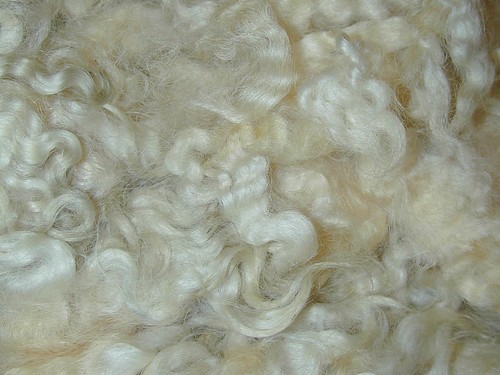
app. 4 pounds of fleece
It came with a card that said the following:
dear claudia,
baaa – enjoy spinning my fleece.
love,
beech
(a white cotswold sheep)
from the sheep & wool festival pittsford, vermont
Isn't that fabulous? It looks soooo clean. The dogs were kinda interested. Hermione, our Border Collie, gave me a look that said "Mom, that is only part of a sheep - I can't herd this..." It was really fun watching her. That is probably the closest she will ever get to a real sheep. Poor un-employed doggie. ;-)
I snapped a bunch of pix while the dogs investigated my present:
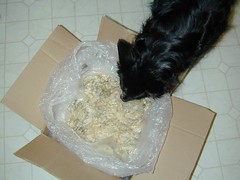
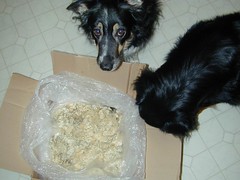
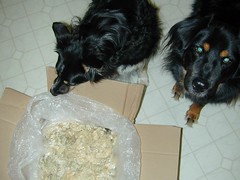
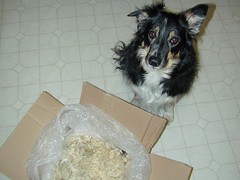
So, here is the story on the fleece. My SIL visited the Sheep & Wool Festival in Pittsford, Vermont. She went with her hubby and her best friend, who owns two Border Collies and sheep. Her best friend started spinning around same time as I did, so was a perfect consultant for my SIL. SIL actually met the sheep's sister, who didn't donate fleece at the festival - too funny. I was told that I would need a flick carder to prepare the fleece if I want to spin it from the grease. It looks very clean to me, so I don't really know if I should wash it or not. Tho', when hubby opened the plastic bag that holds the fleece, he made a funny face and closed it again pretty quickly. Well, it's a fleece and of course it smells a little like sheep. But not bad.
So, I did a little research. Since I am newbie to spinning, I have to learn about the different sheep breeds and the necessary tool. SO - what is a flick carder??? Here is what I found out:
 Flick carders have metal teeth set into a carding cloth. The teeth are slightly bent toward the handle of the wood batt. Flick carders are smaller than hand carders and are used singly. They are simple, efficient to use and prepare wool for spinning worsted yarn.
Flick carders have metal teeth set into a carding cloth. The teeth are slightly bent toward the handle of the wood batt. Flick carders are smaller than hand carders and are used singly. They are simple, efficient to use and prepare wool for spinning worsted yarn.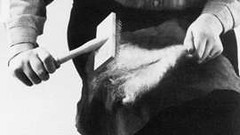 Hold the cut end of the staple of wool in your left hand. Place a piece of leather on your knee and flick the carder at the tips of the wool. This is a hitting, not combing action. If necessary, turn the staple over and flick the other side.
Hold the cut end of the staple of wool in your left hand. Place a piece of leather on your knee and flick the carder at the tips of the wool. This is a hitting, not combing action. If necessary, turn the staple over and flick the other side.Very interesting - I think I'll put this tool on my shopping list for SAFF. Dear readers, let me know if you have any suggestions/comments.
Here is what I found out about the Cotswold Sheep breed:
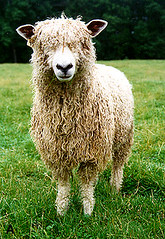
The Cotswold breed originated in the Cotswold Hills of Gloucester, a south midland county of England touching the Bristol Channel. The Cotswold Hills cover an area of about 280,000 acres, have an average elevation of between 500 and 600 feet and are not particularly fertile. The soils do contain considerable lime, and the area raises fair crops of small grains and roots. Because of its mild, temperate climate, the area is well suited to sheep raising. The name "Cotswold" was given the breed because in the early days they were folded or housed in shelters known locally as "cots" or "cotes" and they were pastured on the wild, treeless hills of the area, called "wolds".
It is suggested that sheep were in the Cotswold Hills at the time of Caesar's conquest of Britain, and sheep were mentioned in most of the early agricultural writings of the area. Professor David Low, in On the Domesticated Animals of the British Islands, suggested, however, that the Cotswold breed was not an outgrowth of the early sheep found in the hills, but that the Cotswolds of his day represented selects from the sheep that had been brought into the area from the lowlands. He based his opinion on the fact that the Cotswolds of the middle nineteenth century were a long-wooled breed of sheep, whereas the sheep that had formerly inhabited the hills were noted for their fine wool. It would thus appear that the Cotswold breed had inherited little more than a name from the original sheep that inhabited the area. Breeders of the Cotswold Hills started in about 1780 to introduce Leicester rams into the area to improve the carcass quality of the sheep. During the following fifty years much crossbreeding was practiced, which resulted in a reduction in the size and improvement in carcass quality. After 1825, Cotswold breeders started to select sheep for larger size, a part of which the breed had lost, and for heavier fleeces.
The first Cotswold imported into the United States of which there is record was brought over in 1832. Apparently the breed had been introduced earlier, because when Christopher Dunn of Albany, New York, made his importation, sheep of similar type were already quite common in this country. The breed has served about the same purpose as the other long-wooled breeds in the United States. It has been used for crossbreeding, as a means of increasing the size and feeding quality of lambs, and of getting increased staple length in ewe bands without losing fleece weight. Several large flocks of Cotswolds have been maintained in the western states for production of range rams. Some of these breeders have not kept all their sheep registered, as they have been chiefly interested in the production of rams for the range trade.
To the casual observer, the external appearance of the Cotswold and Lincoln is similar, but there are several differences that are apparent. The Cotswolds are somewhat smaller than the Lincoln, although mature rams in good condition will weigh about 300 pounds and ewes usually around 200 pounds. Cotswolds carry more foretop than do Lincolns, and the fleece is carried in rather bold locks and is usually from eight to ten inches in length. The fleece grades braid but is somewhat finer and softer than that found on the average Lincoln. The fleece will mat or become cotted rather easily and unless it is kept clean and in good condition may become somewhat unsightly. The fleece parts along the back, is rather open and in hard cold rains does not offer a great deal of protection to the sheep. The average ewe flock will shear about twelve pounds annually, while rams should shear appreciably more wool. The fleece of the Cotswold is white. The Cotswold has a white face and white legs, grayish-white color is not considered objectionable, and small black spots on the face or legs are not entirely unknown. They will also exhibit dark pigmentation on the skin of the nose, inside the ears and on the hooves.
Sorry, if that was too much information on one little sheep - I find it fascinating. I am sure I won't remember all of that. But that's why I put it on my blog. ;-)
And - since my last blog entry, I finished another gift from the slowly shrinking Christmas list. Here is the Fair Isle Skiing Hat. Gosh - I am glad this project is done - it only took me three tries...
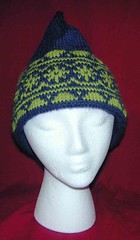
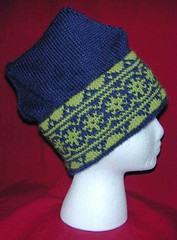
Yarn: Nashua Julia (Midnight Blue & Spring Green)
50% Wool, 25% Alpaca, 25% Kid Mohair - very yummy
Needles: US #5
And I spun some more Corriedale. This time I tried not to twist it too much. I would like to not ply it and knit with a single strand. We'll see how it turns out once I take it off the bobbin.
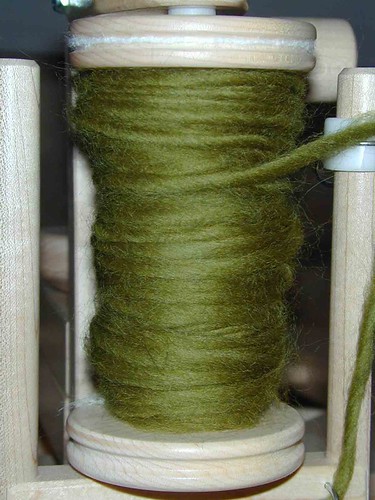
I have noticed that if I spin before bed time I get very relaxed. That's great because I sometimes have a hard time falling asleep if I have too many things to think about.
HAPPY WEDNESDAY!







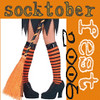








6 Comments:
I might have to pick up some cotswold at the festical now, cause they sheep sure is darned CUTE!!
Hand carders stink, the flicking sounds better because the carders just mess the natural state of the wool all up, in my shoddy experience anyways.
I do NOT like spinning in the grease, it will get on your fingers, your bobbin, your wheel. BLEH! But you can try it! Remember there might be up to half a pound of lanolin sitting in that fleece!
Also imagine if you never washed your hair for 6 months and then ran and ran and ran your hand through it, no one knows where that sheep went so it's also a sanitation concern. HAHA hope I havn't scared you, you can try it, but you know I'm a picky pixie! :)
I spin at night as well.. and I do find that I sleep better on nights that I spin for a while.
I'm glad that you are having fun with spinning!
I just caught up on your entries and you have been so busy with the Christmas knitting!! Wow!! I'm glad that you received something fun in the mail, for you -- I don't spin but I can tell you are having a good time doing the research with your gift. Happy Anniversary to you and your DH. Hugs to the dogs!
The puppies are so precious and funny in these pics...if we could read her mi(o)nd! Looks like you're really a spinner now, girl! And your comments are growing, too!
Now that I started spinning Im always interested in these fiber posts-- I love hearing about what sheep breeds and how well they end up spinning.
Nice blog thhanks for posting
Post a Comment
<< Home